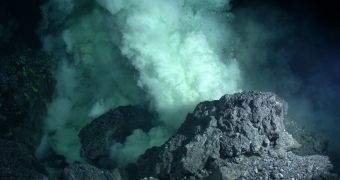A recent paper in the international journal Nature helps provide a better understanding of the so-called black smokers at the bottom of global oceans. Specifically, this paper sheds new light on the underground supply routes that these geological formations owe their existence to.
Specialists with the GEOMAR Helmholtz Center for Ocean Research Kiel explain that black smokers are known to the scientific community as hydrothermal vents.
These geological formations are best described as chimneys from which black water whose temperature is about 300 degrees Celsius (572 degrees Fahrenheit) and minerals shot out.
Some hydrothermal vents stand several meters tall, and they are all driven by what researchers like to call volcanic power plants. Thus, black smokers can be found in all oceans in the proximity of submarine volcanic chains.
Previous studies have shown that hydrothermal vents release whopping amounts of energy. In fact, it is said that some of them release about as much energy that is needed to meet the demands of a small town.
However, it took a while for the scientific community to become familiar with the mechanisms behind these geological formations. Specifically, one question that remained unanswered for quite a while concerned the path taken by the seawater coughed out by black smokers.
In their paper in the journal nature, the GEOMAR Helmholtz Center for Ocean Research Kiel specialists explain that, according to their investigations into the matter at hand, the water released by hydrothermal vents comes from two different sources.
Thus, it appears that some of the water enters the seafloor close to the hydrothermal vents, and then travels up their chimney. However, a significant amount of water seeps into the ocean floor at a considerable distance from one black smoker or another, and must travel a long way before reaching these geological formations.
“There are actually two different flow paths – about half the water seeps in near the vents, where the ground is very warm. The other half seeps in at greater distances and migrates for kilometers through the seafloor before exiting years later,” the scientists explain.
Since black smokers cough out not just hot water but also minerals, specialists argue that gaining a better understanding of how they work can help determine where certain materials are deposited on the seabed, and if some of these ore deposits might be worth exploiting.
“So far, we only know the surface of the ore deposits at hydrothermal vents. Nobody knows exactly how much metal is really deposited there. All the discussions about the pros and cons of deep-sea ore mining are based on a very thin database,” says study co-author Prof. Dr. Colin Devey.
“When we know which paths the water travels underground, we can better estimate the quantities of materials released by black smokers over thousands of years,” adds Dr. Jörg Hasenclever.

 14 DAY TRIAL //
14 DAY TRIAL //